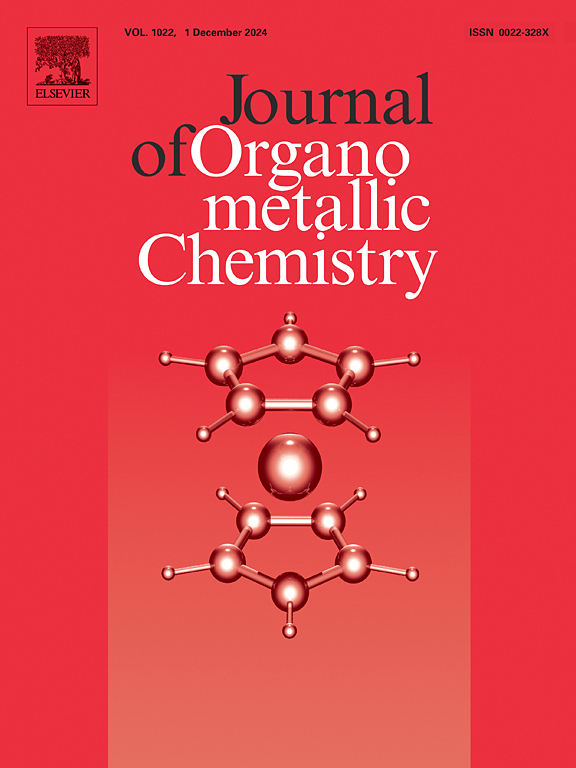甲脒铜(I)的简易合成及其光致发光特性
IF 2.1
3区 化学
Q3 CHEMISTRY, INORGANIC & NUCLEAR
引用次数: 0
摘要
作为研究第 11 组金属氧化物与原配体反应的一部分,一系列发光的双核 Cu(I)甲脒酸盐,[Cu₂(DippForm)₂] (1)(DippForm = N、N'-双(2,6-二异丙基苯基)甲脒酸盐),[Cu₂(EtForm)₂py] (2) (EtForm = N,N'-双(2,6-二乙基苯基)甲脒酸盐,py = 吡啶),{[Cu₂(XylForm)₂py]-py} (3) (XylForm = N,N'-双(2,6-二乙基苯基)甲脒酸盐,py = 吡啶(3) (XylForm = N,N'-双(2,6-二甲基苯基)甲脒酸盐),[Cu₂(MesForm)₂py] (4) (MesForm = N,N'-双(2,4,6-三甲基苯基)甲脒酸盐)、[Cu₂(o-TolForm)₂py] (5) (o-TolForm = N, N'-双(2-甲基苯基)甲脒酸盐)、[Cu₂(CF₃Form)₂] (6) (CF₃Form = N、和 [Cu₂(DFForm)₂(py)₂] (7) (DFForm = N, N'-bis(2,6-difluorophenyl)formamidinate) 是通过氧化亚铜与相应的甲脒在吡啶中直接反应合成的。在复合物 2-5 中,其中一个金属中心被吡啶配位,而在复合物 7 中,每个金属中心都被溶剂分子配位。研究人员对发光双金属复合物进行了固态光物理特性研究。在环境温度和低温下对这些配合物进行的固态测量显示出磷光发射。本文章由计算机程序翻译,如有差异,请以英文原文为准。

Facile synthesis of Copper(I) formamidinates and their photoluminescence properties
As a part of investigating the reaction of group 11 metal oxides with proligands, a series of luminescent dinuclear Cu(I) formamidinates, [Cu₂(DippForm)₂] (1) (DippForm = N, N’-bis(2,6-diisopropylphenyl)formamidinate), [Cu₂(EtForm)₂py] (2) (EtForm = N, N’-bis(2,6-diethylphenyl)formamidinate, py = pyridine), {[Cu₂(XylForm)₂py]·py} (3) (XylForm = N, N’-bis(2,6-dimethylphenyl)formamidinate), [Cu₂(MesForm)₂py] (4) (MesForm = N, N’-bis(2,4,6-trimethylphenyl)formamidinate), [Cu₂(o-TolForm)₂py] (5) (o-TolForm = N, N’-bis(2-methylphenyl)formamidinate), [Cu₂(CF₃Form)₂] (6) (CF₃Form = N, N’-bis(2-trifluoromethylphenyl)formamidinate), and [Cu₂(DFForm)₂(py)₂] (7) (DFForm = N, N’-bis(2,6-difluorophenyl)formamidinate), were synthesized by the direct reaction of cuprous oxide with the corresponding formamidine in pyridine. One of the metal centres was coordinated by pyridine in complexes 2–5 and each metal centre was coordinated by solvent molecules in complex 7. The luminescent bimetallic complexes were investigated for their photophysical properties in their solid state. Solid state measurements of the complexes at ambient temperature and at low temperature show phosphorescence emission.
求助全文
通过发布文献求助,成功后即可免费获取论文全文。
去求助
来源期刊

Journal of Organometallic Chemistry
化学-无机化学与核化学
CiteScore
4.40
自引率
8.70%
发文量
221
审稿时长
36 days
期刊介绍:
The Journal of Organometallic Chemistry targets original papers dealing with theoretical aspects, structural chemistry, synthesis, physical and chemical properties (including reaction mechanisms), and practical applications of organometallic compounds.
Organometallic compounds are defined as compounds that contain metal - carbon bonds. The term metal includes all alkali and alkaline earth metals, all transition metals and the lanthanides and actinides in the Periodic Table. Metalloids including the elements in Group 13 and the heavier members of the Groups 14 - 16 are also included. The term chemistry includes syntheses, characterizations and reaction chemistry of all such compounds. Research reports based on use of organometallic complexes in bioorganometallic chemistry, medicine, material sciences, homogeneous catalysis and energy conversion are also welcome.
The scope of the journal has been enlarged to encompass important research on organometallic complexes in bioorganometallic chemistry and material sciences, and of heavier main group elements in organometallic chemistry. The journal also publishes review articles, short communications and notes.
 求助内容:
求助内容: 应助结果提醒方式:
应助结果提醒方式:


